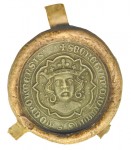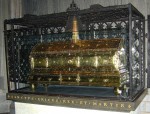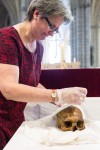 Uppsala University researchers and clerical officials from Uppsala Cathedral opened the reliquary casket of King Eric IX of Sweden, the patron saint of Stockholm, on Wednesday. There’s footage of the solemn opening in this Swedish-language video. The casket was opened as recently as 2000, but the remains weren’t studied or conserved at the time. This year is the 850th anniversary of the establishment of the Diocese of Uppsala as the archbishopric of Sweden and the Cathedral plans an unprecedented exhibition in honor of the jubilee. Since they wanted King Eric’s funeral crown as part of the exhibition, officials decided to amortize the opening by allowing the university to examine the remains.
Uppsala University researchers and clerical officials from Uppsala Cathedral opened the reliquary casket of King Eric IX of Sweden, the patron saint of Stockholm, on Wednesday. There’s footage of the solemn opening in this Swedish-language video. The casket was opened as recently as 2000, but the remains weren’t studied or conserved at the time. This year is the 850th anniversary of the establishment of the Diocese of Uppsala as the archbishopric of Sweden and the Cathedral plans an unprecedented exhibition in honor of the jubilee. Since they wanted King Eric’s funeral crown as part of the exhibition, officials decided to amortize the opening by allowing the university to examine the remains.
Little is known about this king. There are many miracles attributed to him and his remains but not much in the way of historical or archaeological evidence. There is at least one surviving chronicle that mentions him in passing. Most of what we know of him comes from hagiographies that date to the 13th century at the earliest. According to them, Eric was a pious and just king who came to power in 1156 after the murder of King Sverker I. He wrote Sweden’s first law book, hence the nickname Eric the Lawgiver, traveled the country, which still had a significant complement of non-Christians, dispensing justice and founding churches.
 According to these accounts, Eric was killed by nobles who resented his devout Christianity (and the 10% tithe his piety made him enshrine in law) who were in cahoots with Magnus, son of the king of Denmark. He was at church on Ascension Day, May 18th, 1160, when a messenger interrupted services to tell him an army of rebels were coming for him.
According to these accounts, Eric was killed by nobles who resented his devout Christianity (and the 10% tithe his piety made him enshrine in law) who were in cahoots with Magnus, son of the king of Denmark. He was at church on Ascension Day, May 18th, 1160, when a messenger interrupted services to tell him an army of rebels were coming for him.
After mass he recommended his soul to God, made the sign of the cross, and, to spare the blood of the citizens, who were ready to defend his life at the expense of their own, marched out alone before his guards. The conspirators rushed upon him, beat him down from his horse, and struck off his head with a thousand indignities in derision of his religion. His death happened on the 18th of May, 1151. God honoured his tomb with many miracles.
 Eric was venerated almost immediately after his death, his remains collected as holy relics. They were kept at the Trinity Church (the current church by that name was built in the 13th century) in Uppsala where the king was martyred and used in processions every year on May 18th. His son Canute, undisputed King of Sweden from 1173 to 1195, strongly supported the cult of Saint Eric, but Pope Alexander III, who had created the archbishopric of Sweden in 1164, refused to canonize him. In an important (from a canon law perspective) letter he wrote to Canute in the 1170s, Alexander admonished the Swedish church for allowing veneration of a man who was drunk when he was killed by a bunch of other drunks, insisting that the determination of sainthood was solely in Rome’s purview. That may or may not be Eric he was talking about (he doesn’t name the saint in question), but he does say “a great many signs and miracles are wrought by him,” and since he’s addressing the king, it’s a strong possibility he meant Eric. The Swedish church still observes a saint day of May 18th for Eric, even though he never did get the official imprimatur.
Eric was venerated almost immediately after his death, his remains collected as holy relics. They were kept at the Trinity Church (the current church by that name was built in the 13th century) in Uppsala where the king was martyred and used in processions every year on May 18th. His son Canute, undisputed King of Sweden from 1173 to 1195, strongly supported the cult of Saint Eric, but Pope Alexander III, who had created the archbishopric of Sweden in 1164, refused to canonize him. In an important (from a canon law perspective) letter he wrote to Canute in the 1170s, Alexander admonished the Swedish church for allowing veneration of a man who was drunk when he was killed by a bunch of other drunks, insisting that the determination of sainthood was solely in Rome’s purview. That may or may not be Eric he was talking about (he doesn’t name the saint in question), but he does say “a great many signs and miracles are wrought by him,” and since he’s addressing the king, it’s a strong possibility he meant Eric. The Swedish church still observes a saint day of May 18th for Eric, even though he never did get the official imprimatur.
 The reliquary holding his bones and funeral crown was moved to the Uppsala Cathedral, built on the site of the original Trinity Church, after construction was completed in 1273. The current gilt silver reliquary was made in the 16th century. The original one is thought to have been worn out from all the handling during processions. The second was made in 1435 in the shape of a Gothic cathedral. It was melted down in 1573 by King John III to finance a war with Russia. He and his wife then had the current casket made from 75 pounds of gilded silver the next year.
The reliquary holding his bones and funeral crown was moved to the Uppsala Cathedral, built on the site of the original Trinity Church, after construction was completed in 1273. The current gilt silver reliquary was made in the 16th century. The original one is thought to have been worn out from all the handling during processions. The second was made in 1435 in the shape of a Gothic cathedral. It was melted down in 1573 by King John III to finance a war with Russia. He and his wife then had the current casket made from 75 pounds of gilded silver the next year.
 The reliquary was opened and some bones distributed to other churches in the 14th century, so the skeletal remains are not complete. The skull, minus the lower jaw, is still there, however, as are the long bones of the legs and the remains of the collarbone in a special pouch. The new study will examine the cervical vertebra and collarbone for cutting marks. The bones will be measured, X-rayed and DNA extracted if possible. Isotope testing on the teeth will hopefully answer long-standing questions about his origin. (His name, Eric Jedvardsson (son of Edward), suggests he may have English heritage, but the hagiographies claim he was from Västergötland or Uppland, in southern Sweden.)
The reliquary was opened and some bones distributed to other churches in the 14th century, so the skeletal remains are not complete. The skull, minus the lower jaw, is still there, however, as are the long bones of the legs and the remains of the collarbone in a special pouch. The new study will examine the cervical vertebra and collarbone for cutting marks. The bones will be measured, X-rayed and DNA extracted if possible. Isotope testing on the teeth will hopefully answer long-standing questions about his origin. (His name, Eric Jedvardsson (son of Edward), suggests he may have English heritage, but the hagiographies claim he was from Västergötland or Uppland, in southern Sweden.)
That’s all secondary to the main research project: an interdisciplinary study of osteoporosis. The project compares ancient remains to modern ones to study changes in bone density and joint damage from the disease. The Uppsala University team have examined other skeletons from the early Middle Ages as part of this project, but they were all regular folk. Information from an upper class individual will fill in an important blank.
The gilded copper crown with glass stone accents, Sweden’s oldest royal crown, will be conserved and then put on display for the first time in modern memory at the Heaven Is Here exhibition in Uppsala Cathedral from June 18th through November 16th. Celebrating the 850th jubilee, the exhibition features more than 50 historical religious artifacts from diocesan churches as well as installations by contemporary Swedish artists. It’s the first time so large an exhibition has been held in an active church in Sweden.
Opening such an authentic reliquary is always a very exciting moment for historians and archaeologists.
I have got a question about the royal crown. Usually, such a symbolic sign of power is used by the King’s successor (whether an official heir or an usurper) for his coronation ceremony. Isn’t it unusual to lock it in the coffin of the deceased sovereign?
Of course, King Eric IX of Sweden seems to have been considered as a saint shortly after his death…
It is my understanding that this was a crown specifically made for him to be buried in, not the coronation crown or other utility crowns. The relative modesty of the materials — gilded copper, colored glass — underscore its funereal function.
Thank you for these important details!